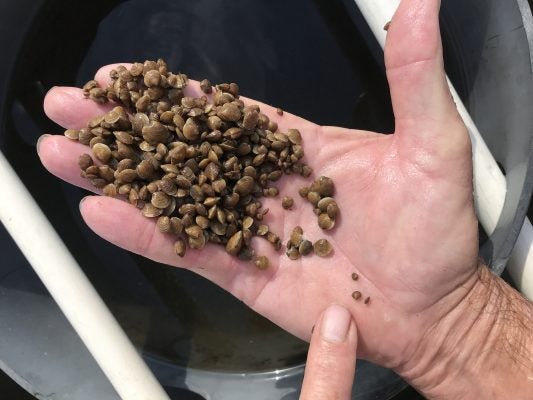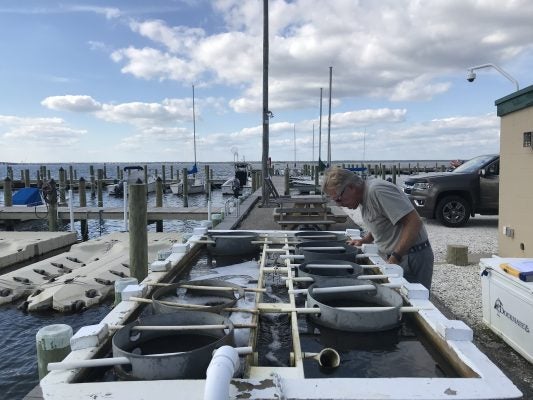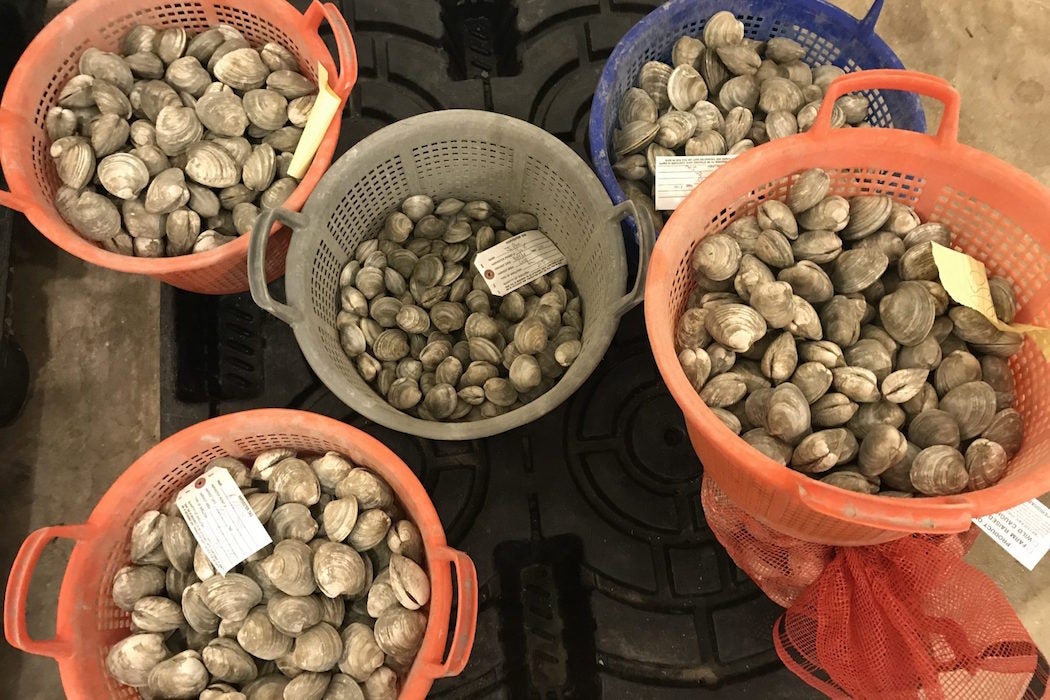In October 2012, as Hurricane Sandy roared towards the Jersey Shore, fire trucks drove the streets of New Jersey’s Long Beach Island blaring mandatory evacuation orders. Rick Bushnell wasn’t worried about his family. His adult children lived with their own kids away from the coast, and he and his wife had already arranged to stay with friends near Philadelphia. Nor was he too worried about his home on the narrow 18-mile-long barrier island—except moving everything in the garage above the high-water mark left by Hurricane Grace in October 1991. There was no way, he assumed, Sandy could be as bad as the Perfect Storm.
But he was worried about the baby clams.
As the founding president of the nonprofit organization ReClam the Bay, Bushnell headed a team of volunteers who’d raised millions of hard clams every year since 2005. The baby bivalves lived in 15′ by 6′ tanks known as upwellers, in eight locations across the Barnegat Bay-Little Egg Harbor estuary system. A sump pump sucked water from the bay into the upwellers, where the clams, housed in 18″-diameter silos, siphoned food from it. The water—cleaner now, thanks to the clams—flushed back into the bay.
The storm might knock out the power to the sump pumps. If that happened, the water wouldn’t be oxygenated, and the clams would suffocate. Bushnell made a decision: All the upwellers would be shut down and the clams would be put into the bay. Bushnell and his helpers poured many of them off the coast of Holgate. They then drained and powerwashed the upwellers into the bay. He hoped they’d remain in place through the coming storm.
By the time he and his wife had finished packing up their car, bay water from backed up storm drains was flooding the streets, lapping at the sidewalk. That was a bad sign: there were six more tidal cycles to go before Sandy was predicted to make landfall. The couple drove across the bridge to the mainland. The clams were on their own.
The Hidden History of Bivalves
Clams, oysters, and other bivalves used to be plentiful in estuaries along the Atlantic Coast and in the Gulf of Mexico. But throughout the 19th and 20th century, their numbers tanked as unregulated harvesting of shellfish combined with rising populations. What remained of the natural environment was flooded with nutrients, such as nitrogen and phosphorus, from our sewers and farms. Algae gorged on them—and thrived. Algal blooms block the light seaplants need for photosynthesis, and as the plants die, the amount of dissolved oxygen in the water plummets—what’s called eutrophication. Animals in low-oxygen waters can suffocate and die.
Pathogens also took a toll on oysters, mainly the parasite Dermo (Perkinsus marinus) and the protozoan Haplosporidium nelsoni (aka MSX). Two years after MSX appeared in New Jersey’s Delaware Bay in 1957, 90 to 95 percent of the oysters there were dead.
But shellfish are making a slow comeback, thanks to concerted efforts to regrow and protect them.
Why? They’re delicious big business, for one thing. According to the NOAA, our appetite for oysters on the half shell and every kind of chowder leads to an annual combined value of clam and oyster aquaculture of nearly $300 million (2014). Sea scallops are an even bigger U.S. market, valued at $439 million in 2015.
They’re also natural water cleaners. While polluted waters can kill shellfish, shellfish can make those waters less polluted. And it has to do with what and how they eat.
Clams and oysters both feed on phytoplankton, microscopic marine algae. Clams eat by sucking in water through one siphon, extracting the algae from it through their gills, and spitting the water back out through a second siphon. They don’t just pull in algae: bacteria, nitrogen, phosphorus, sediments and harmful contaminants get trapped too. A hard clam like Mercenaria mercenaria can filter over 10 gallons of water a day. Oysters can filter three times that amount.
They’re also being promoted as guardians of the coast whose ecological niche may provide natural defense against storms—what’s called coastal resilience.
Enter the Shellfish Gardener
Bushnell has loved clams—mostly eating them—since he was a kid on summer vacation on LBI in the late 1940s. “When I was first learning how to sail, we’d go sailing for the whole day,” he says. “And what you did was, you just jumped over the boat, you felt around, you found some clams, you opened them with your pen knife, and that’s what you had for lunch.”
In the early 2000s, Bushnell, a supply-chain consultant from suburban Philadelphia who had retired to LBI, learned about a “Shellfish Gardener” class being offered through a partnership between the Barnegat Bay Shellfish Restoration Program (BBSRP) and the New Jersey Department of Environmental Protection’s Bureau of Fisheries. The course was created by Gef Flimlin, a marine extension agent at the Rutgers Cooperative Extension.
Flimlin thought it was “nearly impossible” to restore Barnegat Bay-Little Egg Harbor, a 600-square-mile coastal lagoon ecosystem, to what it once was; the year-round population of the region is about 600,000 and grows to 1.5 million in the summer. “Oil drips off their cars, dog poop goes down storm drain and into the bay, stuff runs off their lawns,” Flimlin says. But he thought he could educate people to change their habits—and their impact.
Bushnell signed up for the first class, held at Rutgers Extension. Participants learn about ecology, shellfish biology, growing, and farming for eight weeks in May and June, the spawning season for clams. He was so taken with the work that in 2005 he founded ReClam the Bay to raise funds for BBSRP through grants and public campaigns. In one, they commissioned an artist to create 35 giant clam sculptures, which they sold to businesses across the bay. (They also created a “clam trail map” for people to find all 35; it won a state award.)
Participants of both BBSRP and ReClam the Bay also have to complete 20 hours of volunteer time in the field. Most tend the upwellers. Each of these nurseries contains tens of thousands of clams (species M. mercenaria) that arrive from a shellfish hatchery in early summer as pinhead–sized larvae and grow exponentially over the next four months—as much as 5700 percent in a single season. Every week, the shellfish gardeners—mostly retirees—will clean the upwellers. Several times a year, the volunteers with sieve and sort the clams. They record the clams’ growth by volume, as well as the air and water temperature, and salinity.
By November, the clams, also called “seeds” are large enough (8–15 mm) to plant, in one of the three acre–sized underwater plots ReClam the Bay leases through the NJDEP’s Bureau of Shellfisheries. (There are more than 900 leases throughout the state, most of them for commercial clammers.) They’re then blanketed by a protective nylon mesh that keeps cownose-rays and blue crabs from cracking open their shells and devouring them. According to Bushnell, more than 70,000 clams can fit under a mesh that’s 14’ by 20’. There they stay for another year and sometimes more. Some are then scattered, unprotected, in public areas or replanted in areas NJDEP suggests. At 1.5” wide, they can be harvested.

There are similar shellfish programs along the East Coast and in the Gulf of Mexico. Most involve oysters, but some focus on clams or mussels. Just getting off the ground is the Long Island Shellfish Restoration Project, a $10.4-million project funded by New York State that aims to spawn and grow 179 million shellfish in just two years, two-thirds of them clams. They’ll use 73 floating upwellers to do so. And Philadelphia is constructing the first city-owned mussel hatchery in the Delaware River Basin.
The Unprecedented Damage
Superstorm Sandy made landfall just south of Barnegat Bay on October 29, 2012. More than 150 people died, hundreds of thousands of homes were destroyed, and, according to FEMA, the financial toll was $70.2 billion. “In fact, the extent of catastrophic damage along the New Jersey coast was unprecedented in the state’s history, with the brunt of it occurring in Monmouth and Ocean Counties,” according to a 2013 report from the National Hurricane Center.
Barnegat Bay-Little Egg Harbor was ravaged. Houses, boats, and cars were tossed about in the storm surge like bath toys. Marine scientist Doug Zemeckis, who took over running BBSRP in 2017 after Flimlin retired, first saw the devastation to his family’s summer home in Brick, at the northern part of the bay, in an aerial photo. What the waves hadn’t destroyed of the home—the fifth building from the ocean—had been consumed by fire. All that was left was a hot splotch of flame.
About a week after the storm, Bushnell and his wife returned to LBI. An upside-down boat lay on his neighbor’s dock, but his house was still standing, and water had only entered the garage. It had blown past the 1991 high-water mark by about 18 inches. But much of LBI—home to thousands of people and many million-dollar properties, but essentially a sandbar—had been hit hard. Houses were ripped from their foundations and washed away. Four feet of sand covered some roads. One of ReClam the Bay’s giant fiberglass clams was swept from its spot in front of a local craft store called “Just Bead It” and lay in an intersection five blocks away.
Bushnell checked on the upwellers. Most had survived. One at the Surf City Yacht Club, a couple of blocks from his house, had been moved by the storm waters but was relatively intact. Another, at the Brant Beach Yacht Club, had floated to the surface.. They waded into the water to retrieve it.
There was little hope, he thought, for the clams he’d dumped in the bay near Holgate, which suffered some of the worst damage on LBI. A survey completed just days after the storm found that in Holgate, “the dune system was essentially erased and washed across the island into Barnegat Bay.”
“I sentenced 40,000 clams to death,” Bushnell says.
Re-Clamming the Waters
But did he really doom his clams? Not necessarily. Sandy hit a year into a state-funded research initiative called the Comprehensive Barnegat Bay Research Project. With input from the Barnegat Bay Partnership, which coordinates public and private efforts to restore the bay, the NJDEP chose 11 research projects, funded by $3.8 million, to take its pulse from 2011–2015. The results were published in 2017 in a special issue of the Journal of Coastal Research that included 19 studies.
As a whole, the bay is “a thriving ecological system filled with typical mid-Atlantic estuarine plants and animals,” the authors write in the lead paper. But Sandy’s clouded the long-term data. “As a result,” the authors write, “it is difficult for natural resource managers to clearly relate any one stressor to any specific biological group’s decline or success.”
One assessment of hard shell clams in the bay yielded somewhat good news: While there weren’t as many clams as there once were—a 2011 NJDEP survey found a 57 percent decline since the mid 1980s—Sandy didn’t seem to affect the clams’ overall numbers.
A 2012 survey by the NJDEP’s Division of Fish & Wildlife’s Bureau of Shellfisheries, which sampled 356 locations, estimated there were 138.2 million clams in the bay. “[Sandy] really didn’t have an impact on hard clams,” says NJDEP fisheries biologist Jeffrey Normant.
This isn’t a surprising finding, Normant says. Clams have evolved to withstand such wallopings. But it is promising. Bivalves are thought to be core components of what’s called a “living shoreline,” in which plants and other organisms are intentionally composed (or restored) to create coastal resilience—a natural defense system against erosion, pollution, and storm damage.
“You’re putting in a type of living organism that acts as a structure,” says Normant.
Bivalves fortify shorelines—an important characteristic in an era of climate change–driven storms that are increasing in both frequency and intensity. Oyster reefs reduce wave energy, weakening their force. Mussels cling to and reinforce the edges of marshes, which trap sediments and soak up excess floodwater. And clams stabilize bay beds by burrowing into them—and staying there. Together with submerged aquatic vegetation like sea grass, they help batten down the hatches when superstorms chew up coastlines. They’re superior to the bulkheads commonly used to bolster eroding shorelines, which waves smash against.
Get Our Newsletter
In New York Harbor, where oysters once thrived across 220,000 acres of estuaries, the Billion Oyster Project aims to have that many living oysters by 2035. Since 2014, it’s restored 28,000,000 oysters, filtered 19.7 trillion gallons of water, removed 72,500 pounds of nitrogen, and recycled 1,000,000 pounds of oyster shells, which are collected from NYC-area restaurants.
In a 2016 study, researchers modeled the effects of oyster beds in the harbor on wave heights in two storms: Sandy and a severe 1992 winter storm. In the simulations, the absence of oyster beds—which disappeared from New York Harbor in the 19th century due to overharvesting and toxic waters—led to double the wave energy than found in areas with oyster reefs.
In the Chesapeake Bay watershed, a 2014 agreement between six states and Washington D.C. aims to restore native oyster habitat and populations in 10 tributaries by 2025. So far, nearly 1200 acres have been restored. In one 2003 experiment, scientists restored a marsh at the Chesapeake Bay Environmental Center shortly before, Hurricane Isabel hit. Eight-foot storm surge destroyed a building on the property, but the grasses were intact.
The Nature Conservancy has one of the most extensive oyster restoration efforts in the nation, with multiple projects in the Gulf of Mexico and along the East Coast. On the Louisiana coast alone, the conservancy has built 6 miles of oyster reefs.
Anne Birch, the Florida marine program manager for the Nature Conservancy, who oversees a large oyster restoration effort, says there’s “lots and lots of science” to back up the benefits of shellfish-focused coastal restoration projects. Based on that science, they’ve created an oyster calculator that can be used in project planning.
However, data on whether these “natural infrastructure” programs have lessened storm impact is harder to find. Part of the problem is that the programs were designed to restore habitat, not protect the shoreline, so when you look back to see how effective they’ve been, as the Nature Conservancy is doing for a current study, “you have to keep that in mind,” Birch says. “Their primary objective was not shoreline protection, but it could’ve been a secondary result of the project.”

ReClam the Bay and BBSRP are in a similar boat—they haven’t been collecting long-term data on how shellfish restorations may protect against storms.
Birch stresses that these living shorelines can help protect against everyday storms—but hurricanes are another story. “Once it gets to a hurricane level—we’re not going to get out there and say, ‘Yeah, you’re going to be okay because you have some mangroves or some oyster reefs in front of your property,’” she says. “That’s just irresponsible to say.”
She adds, “You also have to have a pretty healthy system in place. A small thin line of oyster reef won’t protect you. The quality and the size matter.”
A year after Sandy, ReClam the Bay gave the entire season’s batch of M. mercenaria to clam farmers around the bay. They were the lucky ones: Many clammers had lost not only the year’s harvest but also their boats, and went out of business.
In the years since, the organization has grown and planted millions of clams and oysters. This month, the Shellfish Gardener class graduated one of its biggest group, of about 20 students. This weekend, November 3, many of them will gather to “rake out” the clams they’ve been growing and plant them in the wild. So the clams will be happy as clams, burrowing into the bay’s floor and holding it together when the waves come down hard. They may not fully hold out against the more damaging storms, but they can help stave off some of their wrath.







